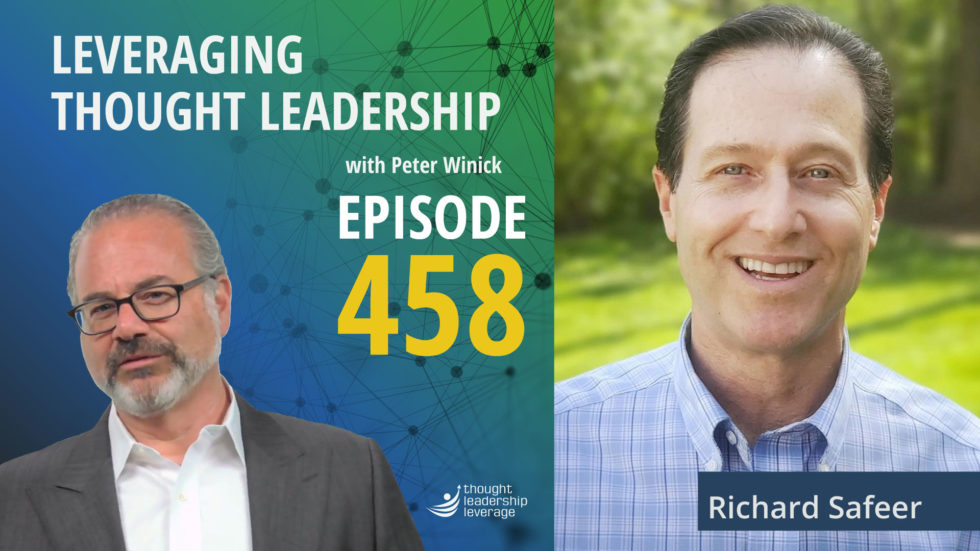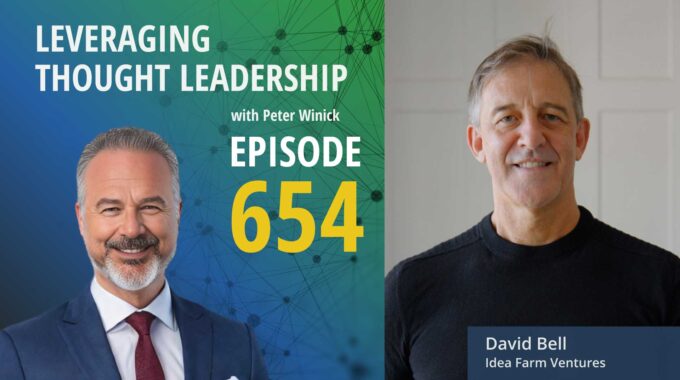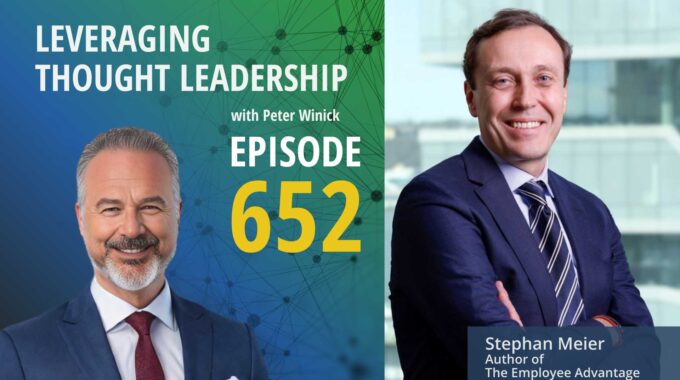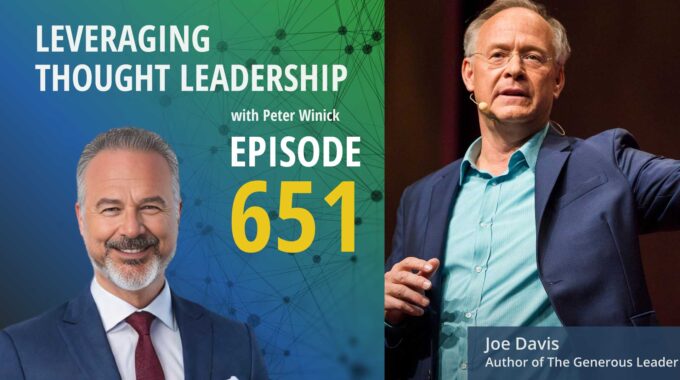Turning frameworks into funding: The hard truth about scaling thought leadership. This episode explores how…
Thought Leader Publishing | Richard Safeer

Creating a Culture of Well-Being.
An interview with Richard Safeer about developing the ideas that would grow to be his first book.
What does it take to put a great idea out into the world – and see it grow?
When you have an idea that can potentially help millions, you have to be ready for the challenges that come along with trying to spread the word.
Our guest today is Dr. Richard Safeer, the Chief Medical Director, Employee Health and Well-Being at Johns Hopkins Medicine. On January 19th, 2023 his first book, Cure for the Common Company: A Well-Being Prescription for a Happier, Healthier, and More Resilient Workforce hits the market, providing practical tips on creating a culture of well-being.
When we think of health and well-being we rarely think of it as a team activity, but we need to have supportive people and supportive environments, including at our workplace. Richard shares how management and HR professionals can be a positive force for workers both in the office and while working remotely.
He tells us about his time working at Johns Hopkins, putting the pieces together to develop an employee health and well-being strategy known as “Healthy at Hopkins,” which would become the basis for his book.
Richard discusses the challenges and growth that were required to get his work to market. He wrote the book without an agent (or contract), but after signing the contract, he realized that – while his work was extremely valuable, it wasn’t entertaining! With inspiration from his favorite authors, Richard rewrote the book, seeking to bring more fun and catch the audience’s attention, while still providing value and practical tips.
Richard tells us how he is not a self-promoter by nature, but the need to get his ideas to the people that would benefit drove him to reach out and learn the skills necessary to market the book.
Three Key Takeaways:
- Ideas for a book can bubble up from decades of work and experience.
- A book that is composed of dry facts probably won’t make an impact. Your work has to be entertaining, in addition to providing value.
- To put your ideas into a practical process, you may need to simplify and focus on the details.
If you need a strategy to bring your thought leadership to market, Thought Leadership Leverage can assist you! Contact us for more information. In addition, we can help you implement marketing, research, and sales. Let us help you so you can devote yourself to what you do best.

Transcript
Peter Winick And welcome, welcome, welcome. This is Peter Winick. I’m the founder and CEO at Thought Leadership Leverage. And you’re joining us on the podcast, which is Leveraging Thought Leadership today. My guest is Dr. Richard Safeer. He is passionate about employee health. He’s got a book that just came out, which is a cure for the common company, a well-being prescription for a healthier, happier, more resilient workforce. He’s the chief medical director of Employee Health and Well-Being at John Hopkins. His work has been recognized by the Center for Disease Control and Prevention, and he’s obviously also a health enthusiast, I wouldn’t expect.
Richard Safeer Yes.
Peter Winick If your hobby used to be French fries, in fact. Yeah.
Richard Safeer That’s bad for PR.
Peter Winick That’s bad for PR. Right? So anyway, welcome aboard. So congrats on the launch and give us a little bit of the backstory because you’re sort of this, when you and I were talking a couple of weeks, we’re getting ready for today, sort of this interesting piece where you’ve created the health and well-being sort of culture and all that inside of Hopkins, and now you’ve really qualified it and are bringing it from a larger universe outside of Hopkins. So, give us the sort of Genesis story.
Richard Safeer Sure. Well, I’ve been fortunate to be in the space for more than two decades, and I have learned from other scientists and researchers about what it takes to set people up for success. Too often we think of health and well-being as an individual endeavor, but we really need supportive people around us and supportive environments, and that includes the workplace. And so about ten years ago, I joined Hopkins and I was able to start putting the pieces together and create a wellbeing culture foundation to support our 42,000 employees. And a decade later, we’re seeing a lot of movement, a lot of progress. And I was thinking, hey, you know what? I’m getting closer to retirement. And I think that it’s time to share some of this with other leaders, managers, human resource professionals and folks who do the same work that I do. Because honestly, Peter, most of the work is focused on the individual instead of Yeah, yeah.
Peter Winick What I’m fascinated about is lots of different companies. So we’ll get to Hopkins in a moment, from Zappos to Google to on and on and on. The list is almost endless. Have taken something that they’ve built internally and then had the author, the thought leaders, the thought leaders codify in some way to share it with a broader population. I’m not sure outside of obviously specific medical knowledge, I’ve seen a medical institution do something like that.
Richard Safeer I’m not sure I have either. There’s other health system employers who are doing great work supporting their employee health and wellbeing. Sure. Yet when I did some research prior to starting the writing of the book, I was looking to see if there were other books that had already. Yeah, laid out a framework and I didn’t find them.
Peter Winick So that’s really that’s really, really interesting that it’s coming from a practice, right? This is not a theoretical because a lot of the times when you get to, you know, obviously in the nonfiction space, there’s this The Crips and the Sharks or whatever. Right. Or the sharks between the practitioners. Yeah. You know, and the academics. Right. It and you know, everybody has a different take where, you know, the academics, everything has to be perfect to the 11th decimal in the book, but you haven’t seen a real client patient or whatever, but you’ve got the real-world piece and the academic piece. And what are the things that you have done at Hopkins that maybe didn’t make it into the book?
Richard Safeer You know, Peter, I’m so glad that you talked about this idea that there’s the science of academics and then there’s the reality. Yeah. And I in addition to my role as the chief medical director of Employee Health and Well-Being, I do have faculty appointments in the School of Public Health and the School of Medicine. And so I work with these faculty members to improve our process. And so, I’ll tell you that when we were working on our, let’s say, our healthy food strategy, there’s the science and all the different nutritional recommendations and the food labeling and there’s a lot there. And yet to put it into practical terms and deliver it in the workplace, we really had to simplify the process because there’s supply chain issues, there’s marketing, there’s advertising. And it’s really much more complicated than one particular research paper can convey.
Peter Winick Now, that’s fascinating. Fascinating. So what I want to understand is, is that to me, what one of the benefits of a book like this is that because it’s not a theoretical. Right. What’s what made it to the book are things that, you know, work because with you have a great laboratory of 42,000 real people. Yes. So where I was going is anything that didn’t make it in the book that, hey, we had this idea that X would be really cool and then we tried it and it was really dumb or it didn’t work.
Richard Safeer Ha.
Peter Winick Failed experiments, if you will.
Richard Safeer Right, right. You know, thank you for asking. I don’t mean to sound like we’re successful all the time, but nothing super comes to mind. And I’m sure that at the beginning of our journey a decade ago, those examples were probably more top of mind, except that we’ve gotten into a rhythm and a pattern so that we are much more efficient and effective in the work we do now.
Peter Winick So let me ask you this then. So well-being has evolved. In lots of ways, but I’m thinking specifically sort of in this we’ll call it post-COVID world, right? Square. Yeah, we have although to a lesser extent in a medical facility, more and more people that will be working remotely in perpetuity, or at least for a large part of their work, whatever, where wellbeing used to equate with we’ll put healthy food in the cafeteria, will encourage people to do a workout on their lunch. We’ll have a gym, but it’s centered on the physicality of the office location. How do we have to broaden or change our thinking now? Realizing that a guy can’t come to Peter’s house every day to feed them lunch or.
Richard Safeer Right, right. And certainly the pandemic has opened our minds to more possibilities. And yet, at the same time, even before the pandemic, we kind of failed to recognize that we had for every employee that we have, we have a different health and wellbeing need, and it’s not possible to create a program for each person individually. So we really need to create this foundation so that everybody feels supported on their own health, well-being journey. Now specifically to your point about the remote workforce, the opportunities are still kind of the same and that their wellbeing journey may not be influenced by the company cafeteria, but the social connectedness aspect of work is greatly influenced by their working at home and we know how important being socially connected is to our own well-being. And so team leaders need to be creative and figure out how to connect with their workforce. So it’s a.
Peter Winick Great point because even the you know, I’ve talked to lots of folks and, you know, one of the benefits of us all being together in the workplace, whatever that is. Yes. If you’re a junior person, whatever that means. Right. You get to see a senior person react in real time to a situation or crisis scenario or whatever. And everything has to be schedule now. And you can’t schedule. You know, Rich will have a real bad crisis at 232 on Thursday.
Richard Safeer Right.
Peter Winick Look around and watch how he handles it. Right. So how do we deal with a world where we have to create opportunities to mentor, to stay connected from a social perspective? As you mentioned, that’s a different way of being.
Richard Safeer Right. Right. Well, I mean, it’s the onus is on the manager and the human resource department to be very intentional about how the employees connect. And there’s a variety of strategies. So some days I’m working in our facilities, Peter. In fact, I go to multiple different facilities and some days I am able to work from home. But on those days I work from home. I often need someone on my team and we’ll go for a walking meeting together so that we can have that connection or we will walk and talk on the phone to have our meetings. So it’s not just through a computer. We’re listening to each other. We’re going to meet as a team in person tomorrow. And so we have to we have all these different ways of connecting and they bring different degrees of opportunity.
Peter Winick Three If you’re enjoying this episode of Leveraging Thought Leadership, please make sure to subscribe. If you’d like to help spread the word about our podcast, please leave us a review and share it with your friends. We’re available on Apple Podcasts and on all major listening apps as well as at ThoughtLeadershipLeverage.com/podcasts.
Peter Winick So I want to pivot a little bit. So this is your first book about it, if my notes are correct?
Richard Safeer That is correct. And my wife also says it’s my last book.
Peter Winick Good. She’s she was. So I want to let’s talk a little bit about the experience of writing the book, what you thought it would be like versus what it was. And you are now in the midst of book launch.
Richard Safeer Yes.
Peter Winick Joyous experiences like for those.
Richard Safeer Yeah, right.
Peter Winick There are two behind you in the book.
Richard Safeer So I thought I had written a book before I went, looked for a book agent and then I was fortunate enough to find the agent and he connected me with Wiley. And then once the contract was in place, I looked at what I had written and realized, Hey, you know what? This information is all true and good, but it’s not entertaining. I need to rewrite the book because when I read a book like some of you had a previous guest, Daniel Pink, he’s one of my favorite authors, are the Heath Brothers. They write entertaining books that provide value and practical tips. And that’s how I ended up writing the book over again. And I feel really good about how it came out.
Peter Winick Right? So just data on a page is not a book, right? It’s the art of the storytelling and weaving it together and that.
Richard Safeer Yes. So. Yeah, right. So. Their stories about Hopkins are stories about other companies. I give a little bit of my own personal well-being journey. It really comes together.
Peter Winick Right. So normally as a doc and in your position, storytelling is probably not all that important.
Richard Safeer Well, I guess that depends on that physician’s style. I mean, I think it’s a no matter what field we work in, it’s important to connect with people. And for a practicing physician, if you don’t have a good rapport with your patient, the likelihood that they’ll listen and engage in a good practical outcome is much lower.
Peter Winick Yeah. Interesting. Okay.
Richard Safeer That’s part of bedside manner. I mean, it really is. Yeah. What I’m thinking.
Peter Winick When you wrote the book, you wrote it the way you thought. A writer writes being probably more of a been to academia, a scientist. Then how do I make this relatable to a layperson? Non M.D., right?
Richard Safeer That’s well. Right. I wrote it. I mean, the second time I wrote it, I wrote it as if I was going to read it. And that’s what made it a good book.
Peter Winick That’s fantastic. I think that’s a great advice as to every author should write it as if they’re they would actually read it.
Richard Safeer No, absolutely.
Peter Winick And I think that’s interesting because, you know, listen, I’m surrounded by books. I love books. I mean, I.
Richard Safeer See I see your bookshelf.
Peter Winick Yeah. But I never care about the 20, 25 bucks or whatever it is that you spend on a book. What I care about is, is this worth the investment of 5 to 8 hours of my life because that I can never get back? Right. That’s true. And it’s rare that I won’t complete a book that I start and I’m doing that more often lately. That might be stubbornness, but, you know, what are you getting for this investment of time? What am I, you know, 5 to 8 hours of my time? That’s a lot of time. That’s I want to get something in exchange for that. I want to have a different way of seeing the world or thinking or at least challenge my preexisting thinking or add something new to it. Let’s go to the launch piece, because most authors think the hard part about being an author is the authorship, is the writing. And I’m I that is hard. I’m not saying that. But then there’s this whole other thing that the publisher and the PR people say, Oh yeah, we’re going to go into book launch mode richer. And you go, Yeah, okay. Interesting. Is that north of Switzerland, right in the midst of it. What is that been like?
Richard Safeer Yeah, you are right. I thought the writing of the book was going to be the hard part, but the challenge and the growth continued into the marketing phase. I don’t think of myself as a self-promoter. And so getting into this comfort level of promoting the book has been a growth opportunity for me as an individual that has pushed my comfort zone. But I think that my high school theater experiences have come back to me. Those times in high school or I was part of musicals have actually served me well lately.
Peter Winick Got it. So but I think it’s you said you’re not a self promoter. I would argue that there is a point, a moment in time, you know, during book launch where your job is to be the evangelist for the ideas, whether you benefit from it or not. I mean, you’re advocating ideas, right? And you.
Richard Safeer Do. Yeah.
Peter Winick Even what you wrote and you want to get it out there to more people. Right. Actually have to pay.
Richard Safeer Up.
Peter Winick To you. Unleash the power of the ideas now in my life, how you put it, you didn’t say I’m comfortable. You said growth, which I love.
Richard Safeer Yeah.
Peter Winick It’s not in your lane. In your zone is not what you’re used to.
Richard Safeer Yes.
Peter Winick What is what are some of the hacks or the tricks. I like the musical theater piece or. Yeah, I could sing some Hamlet. Maybe we have some time left, but what are some of the other sort of things that you’ve learned? Let me sort of frame this in what I hear from lots of my author. Friends are, Oh my God, it’s so monotonous, right? Like, I feel like I’m doing ten interviews like this other than mine today, obviously. Yeah, I got to get the same. I got to get my talking points. I got to do this, I got to do this. And how do you approach each one realizing that whoever the listener or the viewer or whatever is, it’s their first time being sure.
Richard Safeer Well, Becky Robinson, the founder and president of We Think Influence, who.
Peter Winick Is also going to get you.
Richard Safeer Yeah. Who’s been helping me with the book launch told me early she said, listen, you’re not promoting yourself. You’re promoting the book. You know, people don’t read the book. That means that there are millions of employees who are not being helped. And that mindset has really helped me because that is that’s what I maybe share with you. Ten, 15 minutes ago, Peter, the goal of the book is to help more people. And so that alone has really gotten me over a hurdle. So every time I have a conversation, I just know that it’s possible that I’m going to connect with one or more people in that audience, and that can make a difference. To the people they touch.
Peter Winick Yeah, really, really well said. And then, you know, the reality is there is a disconnect between the cadence of the publishing world like, oh, we got 90 days to do book launch. And the reality the reality is your book is an evergreen book. Whether I read it today or in six months from now or 18 months from now or whatever, I could still have that same Aha. And, and do something with it. But the reality is we can’t stay in launch mode. That’s right. Like, that’s like we have things to do.
Richard Safeer Right. Right. I think this book is going to be a resource for most leaders and human resource and folks who are in the health and employ health and wellbeing space because there are practical tips about how to go about creating this wellbeing culture. And there we I turn it around on the reader. Yeah. How is this helping you and your work day? I also reference, you know, we talked about science versus entertainment and there’s a balance here. So there are dozens of references in each chapter so that the readers know what they’re reading is merit and that they can come back to the book and count on it to be a good source.
Peter Winick Well, that’s great insight and thank you for sharing that. Any final thoughts or anything you want to share? Before we go back to a healthy day.
Richard Safeer I would just ask folks to look at the book on Amazon.com. The look inside feature is available so you can get a taste of it. You could also go to Richard Sephora.com. If you want to learn about well-being, culture in the workplace, more open your mind to the possibilities that wellbeing is not about just about the individual, it’s about the organization as well.
Peter Winick Thank you. Great stuff. Thanks for spending some time with us today. I appreciate it.
Richard Safeer Thank you, Peter.
Peter Winick To learn more about Thought Leadership Leverage, please visit our website at Thought Leadership Leverage dot com to reach me directly. Feel free to email me at Peter at ThoughtLeadershipLeverage.com and please subscribe to Leveraging Thought Leadership on iTunes or your favorite podcast app to get your weekly episode automatically.




